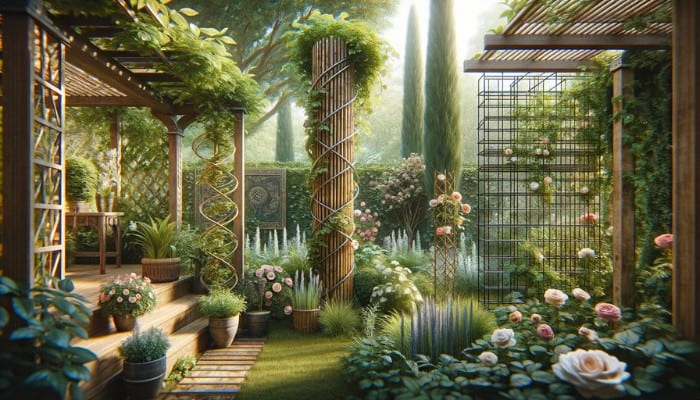Trellises are not just a functional element of your garden that supports climbing plants and vegetables; they are an opportunity to inject charm, elevate the aesthetics of your outdoor space, and even create alluring focal points. With the growing trend of outdoor living, stunning trellis designs have captured the imagination of garden enthusiasts and designers alike.
Whether you have an expansive garden or a cozy balcony, trellises offer a vertical canvas for personalization and innovation. In this extensive guide, we will explore the various ways you can transform your green spaces with trellis designs that merge practicality with beauty.
The Functional Elegance of Trellises
Trellises date back to ancient times when the Hanging Gardens of Babylon used elaborate trellis systems to train plants into intricate designs. Today, trellises serve a dual purpose of being both a practical tool for vertical gardening and a stylish addition to any outdoor area.
By utilizing vertical space effectively, trellises enable gardeners to maximize their planting areas, providing support for climbing plants such as roses, jasmine, and tomatoes. The act of growing plants vertically not only adds an aesthetic appeal but can also facilitate better air circulation, sunlight exposure, and pest control.
Selecting the Right Material for Your Trellis
When it comes to material choices for your trellis, there’s a spectrum of options that cater to different tastes and needs. Wood is a popular choice for its natural appeal and versatility. Cedar and redwood are lauded for their durability and resistance to decay, making them ideal for long-term investments.
Metal trellises, while often more modern in design, offer strength and a sleek look that can complement a contemporary garden. For a softer touch, consider wicker or bamboo. Each material brings its own set of characteristics that can influence the overall look and feel of your trellis.
Integrating Trellises into Small Spaces
Even the most limited of outdoor spaces can benefit from the addition of trellises. In a small balcony or courtyard, a trellis can serve as a privacy screen while housing compact climbers like petit pois or morning glory. The key is to maximize the use of the vertical plane without overwhelming the space.
There are many trellis ideas, so one can install trellises on walls, as standalone fixtures, or even incorporate them into furniture pieces like benchbacks or decorative panels. The result is a cozy, green oasis that makes the most out of every square inch.
Large-Scale Impact with Statement Trellises
For those with expansive gardens, consider trellis designs that make a grand statement. These might take the form of arched walkways smothered in fragrant blooms or towering structures that break up the landscape or delineate specific areas of your garden.
Large-scale trellises can also be functional in shades or as partitions to create outdoor rooms. The scale and design of your trellises should harmonize with the overall design of your garden, anchoring it while also allowing for seasonal adjustments and plant variety.
Layering and Creating Visual Interest
Layering is a principle of design that is as relevant in landscaping as it is in interiors. By introducing trellises of different heights and designs, you can add depth and visual interest to your garden. This can be achieved by using trellises of similar materials in a graduated series of sizes or by juxtaposing different styles for a more eclectic look.
Pairing trellises with other vertical elements such as living walls, fencing, or structures can create a harmonious composition that feels intentional and engaging.
Protecting and Maintaining Your Trellises
The longevity of your trellises depends on the care and maintenance they receive. Regular inspections for damage are recommended, especially if your trellis is supporting heavy plant growth, like melons. Look out for rot in wooden trellises or rust in metal ones.
Painting or sealing the trellis can help prevent weathering while avoiding overloading with plants beyond its built capacity is important. Winter care may involve disassembling, storing, or protecting trellises to ensure they’re ready to support your garden’s growth in the spring.
Eco-Friendly Trellis Options
Recycled materials, such as composite wood or plastic lumber, can mimic the look of traditional wood with added durability. Living trellises, created by training fast-growing plants or vines onto a frame, are also an environmentally conscious choice, contributing to carbon sequestration and providing habitats for local wildlife. These options showcase that practical garden structures can also be part of a green living initiative.
DIY Trellis Projects for the Creative Gardener
For the hands-on gardener, there’s nothing quite like the satisfaction of a do-it-yourself (DIY) trellis project. With a bit of creativity and some basic tools, you can craft trellises from virtually any material, from repurposed pallets to retired ladders.
The DIY approach allows for complete customization, so you can design a trellis that perfectly complements your garden’s character. Plus, it’s a budget-friendly way to introduce trellises into your garden in a truly unique way.
Trellises are an indispensable component of a well-designed garden. From the functional to the decorative, trellises present a world of possibilities that can be tailored to any space or style. They embody the potential for creativity and expression, providing the perfect stage for your plants and flowers to thrive.
Whether you opt for a classic wooden trellis or an innovative living structure, the art of trellising is the art of melding botany with design. By integrating these principles into your garden, you are sure to create an outdoor space that is both verdant and visually captivating.

